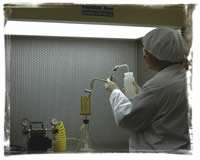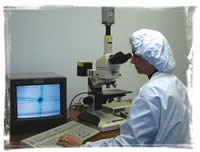Precision Cleaning and Verification: A Practical Guide
Three main issues to consider when deciding on cleaning practices include manpower, equipment and processes and the environment...
During the last several years, the trend among large manufacturers has been to pass cleanliness requirements on parts and assemblies to their subtier suppliers. Many quality managers and process engineers have been caught ill prepared or perhaps even totally unaware of the issues involved in precision cleaning and verification.
Long ignored, and still somewhat underestimated, the importance of part cleanliness is rapidly coming to the forefront in many of today’s high-tech products. Historically, many producers have dismissed parts cleaning as an insignificant step in the manufacturing process until they experience field failures and are faced with a barrage of customer complaints. Many learn all too late that their highly engineered, closely toleranced device is rendered inoperable by a tiny particle, often times so small that it cannot be seen with the naked eye. Suddenly, they are faced with a steep learning curve for a myriad of equipment as well as chemistry, staffing and environmental issues. The field of parts cleaning is a wide one, ranging from “gross” cleaning of heavy industrial components to “critical” cleaning for the space program in Class I clean rooms.
Featured Content
This paper discusses small to medium-sized “aerospace quality” parts. There are many factors that must be considered when deciding which processes best fit a particular situation. The top three factors are manpower, equipment and environmental concerns.
Manpower is the first factor to evaluate. To many, precision cleaning and verification are relatively new and mysterious subjects, and experienced people are scarce. If a customer has imposed a cleanliness specification, that is a starting point; it is now a matter of compliance. If the customer has not supplied a specification, a shop needs to find someone experienced in selecting an appropriate cleaning process and verifying its capability. The biggest question is how clean do the parts need to be, and who determines this?
One way is to have experts from a job shop that specializes in this field determine how clean the parts are. Another method is to send parts out for evaluation. They can be quantitatively tested, and the existing level of cleanliness (or lack thereof) determined. Based on the material and the geometry of the part, a cleaning process can be recommended and an experimental run made. Parts from the experimental run are then tested to quantify the cleanliness level achieved. Then part functionality is tested in the job shop’s actual application. If satisfactory performance is achieved, the level of cleanliness and the job shop’s methods become the benchmark.
Equipment and process are the next factors to consider. The volume, the type of contamination and the material and complexity of the part determine which equipment and processes to use. There are several options, most of which entail significant capital expenditures. It is always best to determine the nature of the contaminant to see if it can be eliminated from the manufacturing process.
Even if the contaminant can be eliminated or reduced, precision cleaning may still be necessary to ensure smooth operation of a closely toleranced mechanical assembly. There are many cleaning options: vapor degreasing, pressure washing, ultrasonics, CO2 snow and mechanical blasting followed by a filtered rinse are common ways to achieve a high level of cleanliness. For removing the smallest and most tenacious particles, particularly on parts with complex geometries, ultrasonic cleaning is very effective. Many frequencies are available, but, as a rule, “the finer the particles, the higher the frequency.” Frequency also directly influences how the parts survive the process. Low frequencies (in the 25Kh range) can literally shatter delicate material or introduce microcracks that may escape detection.
Chemistry is as important as the equipment. Often, the customers dictate what chemistry they want the job shop to use; consequently, the shop has many different brands. They are all relatively good under certain conditions, but the variables are many: concentration, temperature and time to name a few. It is best to work with a company that is service-oriented and willing to demonstrate the effectiveness of its products. As with the equipment makers, most chemical suppliers have labs to do this type of development work.
Rinsing, drying, preserving and packaging all present their own little nuances. For spot-free parts, a DI water system is needed. It should be to a purity of at least 50 mega ohms and filtered to £ 1m for good particle control. Parts drying can be the most time-consuming step in the whole operation. Options range from blowing down parts with shop air to vacuum bake out ovens. A device that has proven convenient and cost effective is a portable dryer consisting of a small electric turbine that produces heat via mechanical friction. The intake is filtered to 3m to ensure purity at the output. Parts are blown dry and re-contamination is not a problem because of the oil trap on the shop air compressor.
Quantitative verification of the cleaning process is fast becoming the prominent factor in the cleaning industry. Automated, laser-based particle counters, microscopes coupled to dedicated PCs, micro balances and nano scales, along with all the peripheral sample collection equipment, including the lab, will run into many tens of thousands of dollars.
There are two commonly accepted methods to obtain cleanliness samples. One entails spraying the test part with sub-micron filtered solvent from a pressurized spray can, collecting the effluent and running it through a vacuum filter funnel, depositing the debris onto a pre-weighed and/or gridded filter. The second method is to sonicate the parts in solvent, remove the parts from the bath, rinse them with additional solvent, collect and filter the effluent as in method one.
The most commonly called out particle analysis criteria are the following: count, maximum particle size and weight. It is not uncommon to see a combination of two or even all three. Reading the following specifications provides a good understanding for this entire process. ASTM F 303 “Sampling Aerospace Fluids from Components” and ASTM F 312-97 “Microscopical Sizing and Counting Particles from Aerospace Fluids” offer a good understanding of how to obtain the sample. National Aerospace Standard 1638 “Cleanliness Requirements of Parts used in Hydraulic Systems” explains how to categorize them. The specifications do not describe how to clean the parts; they govern the test procedures, cleanliness levels and the environment for the testing them.
Environmental issues, although covered last, should be a major concern because they can cause the most headaches. Nothing is worse than developing a process and having it installed only to find out that the municipality will not issue a permit to run it.
What will be removed from the parts, and what will be done with it? Are local, state or federal permits to store, use and dispose of chemistry required? What will happen to spent cleaning solutions and rinse water, both of which will contain the contaminants removed from the parts? Will one or both of them be reportable as hazardous in the waste stream? In most cases, it is cost effective to purchase an evaporator to reduce wash and rinse water volume. What about the effect of this chemistry on employees? Is it safe? What are the exposure limits? Some alkaline cleaners are highly caustic and can burn the skin and irritate the respiratory system with limited exposure. Investigate this area fully before committing too much time or money on equipment and manpower.
There are innumerable details to research with regard to precision cleaning. Once a shop has waded through all of the aforementioned questions (and probably more), it has to decide who will best accomplish this? Can the shop justify an in-house cleaning system, or should it out-source cleaning to a vendor that specializes in the field, leaving its own personnel to concentrate on what the company does best?




















